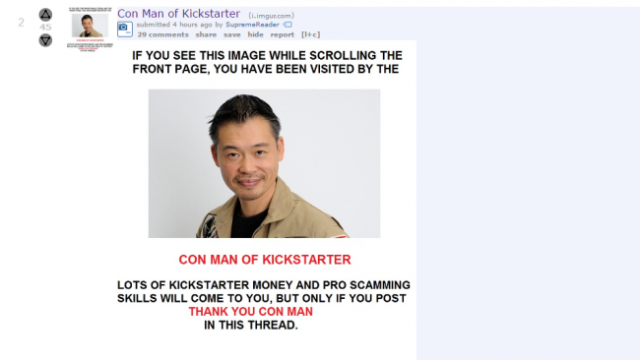You won’t believe what I’m going to say in this article!
It’s the shocking truth about why hype marketing is ineffective!
Bet you can’t guess how many times I’ve gagged while writing this intro!
Find out how many exclamation marks we can fit into an introduction!
If you’re anything like me, you’re sick to death of this style of marketing. Even without reading the content, it’s abundantly clear that these claims or promises are ones which cannot be kept.
Clickbait like “9 Simple DIY Marinades You Won’t Believe Are Made With Gin” might get you the odd click, but even if you have something valuable to convey, there’s going to be damage to your brand by making such ridiculous claims.
Unfortunately, the term “clickbait” no longer adequately covers the damaging practice of hype marketing. Hell, even BuzzFeed themselves published an article stating that they don’t use clickbait headlines (the beauty of which is displayed by one of the highest voted comments on the article containing this site search).
Hype marketing no longer has to generate solid promises of the amazing things you can do with a product; it only has to build the impression of these lofty statements to result in a net loss.
Famous names brought in that have nothing to do with the subject matter, statistics so bad that they’re laughable, pretty much anything which could be considered style over substance will have a negative impact in one way or another.
On the other hand, you have what I call the Hemingway style of marketing (which is actually the iceberg theory):
“If a writer of prose knows enough of what he is writing about he may omit things that he knows and the reader, if the writer is writing truly enough, will have a feeling of those things as strongly as though the writer had stated them. The dignity of movement of an iceberg is due to only one-eighth of it being above water.” – Ernest Hemingway, Death in the Afternoon
Think of it this way: Instead of telling the audience anything and everything with an aim to manipulate emotions, rather than sense, you do the complete opposite. Say what needs to be said. No waffling. Short, direct sentences that don’t shout at the user like a con man at Coney Island.
Just in case you’re not convinced of the danger of hype over Hemingway, let’s break down the topic into sizable chunks. By the end, you’ll be running scared from hype and getting familiar with value-based marketing instead.
Marketing creates expectations
Whether you’re blogging, creating videos, or emailing pitches, marketing is the primary source of information your audience has before they get hands-on with your product.
As such, their expectations of your product are entirely formed by your marketing, plus any information they can gather from other sources (external reviews, perhaps a friend’s recommendation, etc).
If you state your product to be God’s gift to man, other than alienating the large part of your market who won’t believe you, you’ll very quickly lose those customers who try out your product and realize the truth.
At the very least, if expectation doesn’t meet reality, even a good product will be seen as a failure.
Take the recent debacle with Mighty No. 9 – a game which had every right to succeed. It was a spiritual successor to a beloved franchise (Mega Man) that had largely been abandoned, had one of the lead influencers of the old series at the head (Keiji Inafune – lead illustrator and character designer of the early Mega Man titles), and successfully crowdfunded almost $4 million of a $1 million goal.
What marketing feat allowed them to reach $4 million in crowdfunding? Easy; the hyped expectation of a true sequel.
Although there were several problems later down the line, the original pitch was strong and promised “Classic Japanese side-scrolling action, evolved and transformed by Keiji Inafune, an all-star team of veteran Mega Man devs…and YOU!” This alone was more than enough to hype up the old fans and make them vote with their cash.
Sadly, upon release, it was “okay” at best; a fact which, combined with the expectations of the fans who backed the game, resulted in the widespread description of the product as being “disappointing.”
That word itself is a death sentence for a product team – especially one which focuses on marketing.
People love “bad” stuff: sitting down to watch Sharknado, playing Ride to Hell, or watching the online Jesus Disco is fun. Even boring products can be made interesting with a killer marketing campaign.
However, once something’s labeled “disappointing,” it will never be known for more than its worst aspects.
Hype marketing dooms more than your product
The entire purpose of hype marketing is to generate a specific (and highly appealing) image of the product you’re promoting. Now, the same could be true of any great marketing campaign, but there’s one key difference with hype: the image you paint is misleading.
Take, for example, the entertainment industry. The whole purpose of a movie’s trailer is to make you want to see the film. But there are cases when this goes too far and attempts to cash in by marketing to a wider audience.
The Village (to name an example) was a decent movie almost ruined by hyped up, misleading marketing. The trailer for the film presents a monster horror flick: a village surrounded by woods containing unknown beasts which both protect and trap the inhabitants.
Instead, viewers are treated to something more akin to a period romance with the occasional tense moment and a trademark Shyamalan twist. It’s still a decent product for the most part, but going into it with false expectations sours any positive impression an audience can get.
When you combine this image with the expectations of your audience, an overly hype-based marketing campaign can not only make a laughing stock of your product, but irrevocably damage your brand.
For example, Keiji Inafune’s reputation as a result of Mighty No 9 has taken a hefty blow. To quote David Sanchez, at best he’s “not the flawless developer he was so often regarded to be,” and at worst he’s labeled a straight-up con man.

Value-based marketing is a win for both sides
Hemingway-style marketing (the iceberg theory) comes with very few of the risks associated with hype, and is typically more substance over style. Everything unnecessary is taken out and the maximum value of your product is conveyed in the minimum amount of time.
Sound easy? Well, not quite.
Hemingway isn’t about drowning your audience. Say what you need to, ensure that it is true, omit anything that detracts from the experience. Any more than that and you’ll sound like Tom Waits flogging a miracle product.
A good example would be a video ad for the Dollar Shave Club – the founder of the site addresses you directly and immediately tells you what the company does, how much it costs, and highlights what other companies (without naming names) are doing wrong.
“Do you like spending $20 a month on brand name razors? 19 go to Roger Federer.” – Michael Dublin, founder of Dollar Shave Club

This style of marketing does one better though. It inherently portrays the product as being more trustworthy in the eyes of your audience. Any expectations set out by an iceberg campaign are going to prove either accurate or lower than the experience the user will receive.
As a result of this, the risk to your reputation should the product fail is less (in the eyes of the public at least). Nothing is wasted and so the user doesn’t get bogged down in unnecessary detail and flim-flam.
Shorter does not, however, equal easier.
Anyone can say the words, “You buy one, you get one free” over and over, but a true master of the written word (whether it’s fiction, fact, or the murky waters of marketing) can spend hours upon hours perfecting a single, short element of their work, such as a headline.
Done right, value-based marketing is more effective and contains a lesser risk to your brand then pure hype, but the road to this isn’t going to be easy.
Be concise, truthful and valuable
In short, take heed of the warnings from hype-heavy marketing campaigns and take a leaf out of Hemingway’s book.
Audiences aren’t sick to death of clickbait because they didn’t like the order of the words; it stopped working because of the false expectations that were dashed upon opening the article.
They’ve been called out so many times that the very bait being used becomes a deterrent.
“The sixty odd characters we’re given to write an email subject line shouldn’t be thought of as restrictive. They’re liberating.” – Paul Talbot
Choose Hemingway over hype. Convey exactly how your product is valuable and set the right expectations from day 1. After all, when spoof articles are about as believable as your advertising, the only thing you’re doing is making the rest of the industry chuckle in despair.
Seeing as this is such a heated topic, why not drop a line in the comments? I’d love to hear your thoughts on the issue (or even a short rant on your biggest offenders for hype).






